Remember when makeup wasn’t afraid of the dark side?
The ’90s vampy aesthetic wasn’t just a trend—it was a revolution that gave beauty lovers permission to embrace their inner goth goddess.
With celebrities like Drew Barrymore, Winona Ryder, and Neve Campbell leading the charge, these dark, moody looks defined an era of rebellious glamour that still influences today’s beauty scene.
Check these iconic looks what will transform your makeup routine faster than you can say “The Craft.”
Deep Blood-Stained Lips: The Ultimate ’90s Power Move
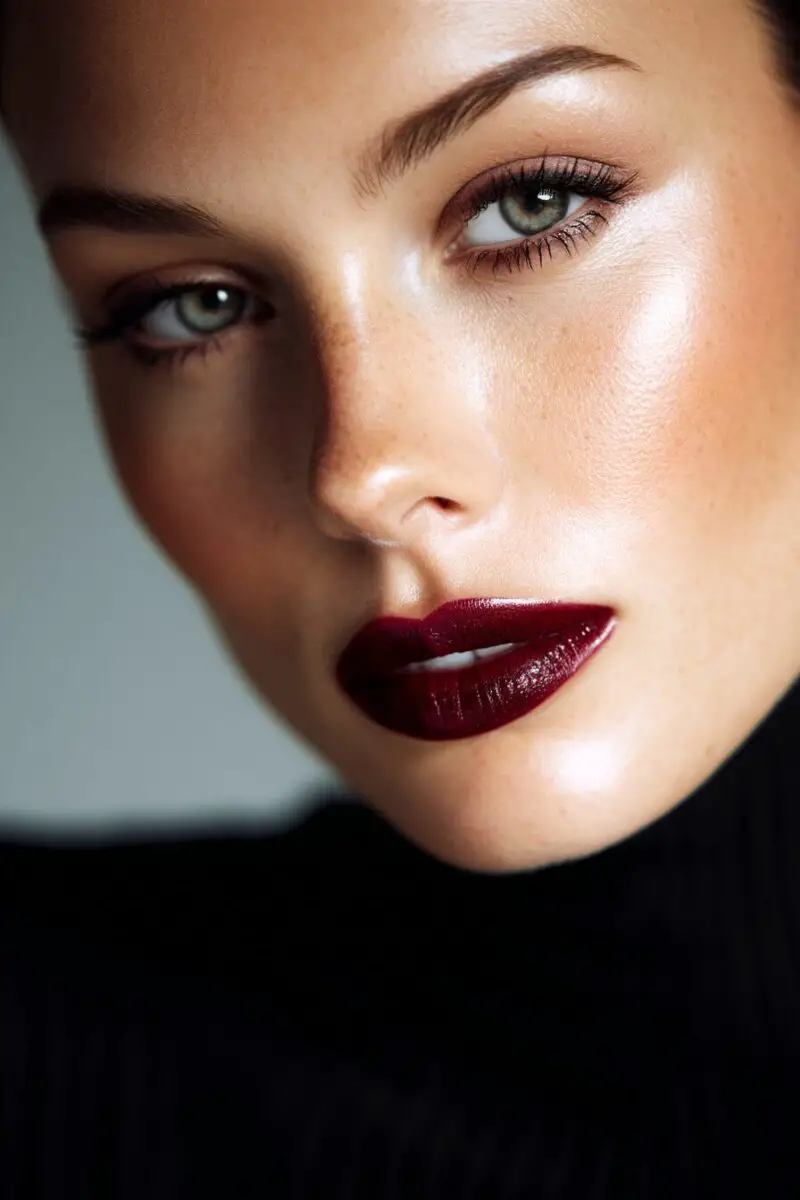
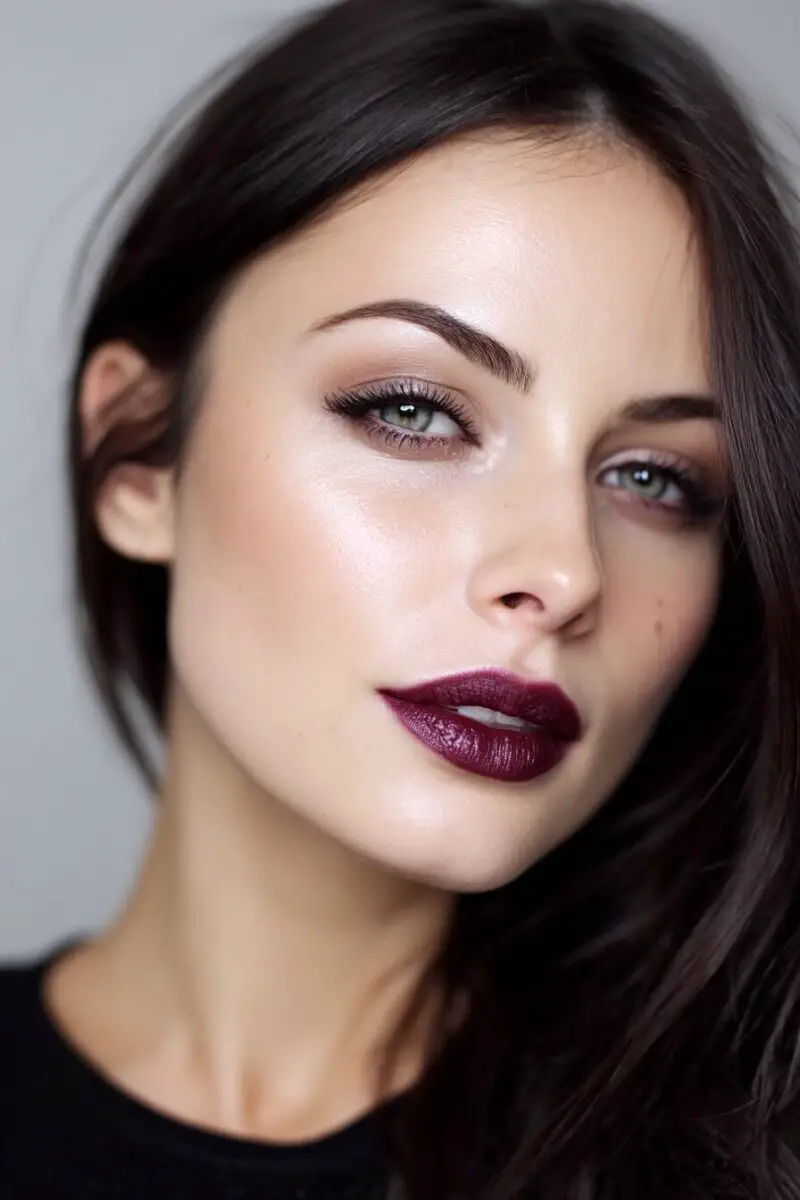
The cornerstone of any vampy ’90s look began and ended with those deep, dark, almost-black lips that screamed attitude from across the room.
Unlike today’s precisely lined pouts, the ’90s vampy lip featured slightly blurred edges that gave an effortlessly cool, just-devoured-something-sinful vibe.
To recreate this look, reach for deep burgundy, blackberry, or brown-toned red lipsticks that make your teeth appear whiter while lending mystery to your smile.
MAC’s “Diva” and “Media” remain cult classics for a reason, but modern formulations like Fenty Beauty’s “PMS” or Maybelline’s “Midnight Merlot” deliver that perfect ’90s depth with improved wear time.
The key to nailing this look lies in the preparation—gently exfoliate lips first, then apply a thin layer of foundation or concealer before lining the entire lip with a deep pencil.
Fill in with your vampy lipstick using a brush for precision, then blot with a tissue and reapply for intensity that won’t quit before midnight.
For darker skin tones, look for deep purples with blue undertones that create stunning contrast, while fairer complexions can experiment with brick reds that avoid washing you out.
Pair this statement lip with minimal eye makeup to stay true to the ’90s aesthetic, when beauty rules embraced the dramatic imbalance of a single focal point.
Remember that confidence is the most important accessory with this look—the ’90s vampy lip wasn’t for the faint of heart then, and it still demands the same fearless attitude today.
The beauty of this look lies in its versatility—wear it to everything from dive bar concerts to gallery openings for an instant edge that transcends decades.
Smoked-Out Grunge Eyes: The Perfect Imperfection


Unlike today’s precisely blended, multi-dimensional eye looks, ’90s vampy eye makeup embraced the lived-in, slept-in, couldn’t-be-bothered aesthetic that defined the decade’s grunge attitude.
The secret to authentic ’90s smoked-out eyes wasn’t precision but the deliberate lack of it—think messy, slightly smudged liner that looked like it survived an all-night party at a Seattle music venue.
Black and deep brown pencil liners were the weapons of choice, applied heavily to the upper and lower lash lines, then intentionally smudged with a finger or small brush for that coveted morning-after effect.
Urban Decay’s aptly named “Oil Slick” and “Smog” shadows were staples for those who lived through the era, but today’s equivalents like the Anastasia Beverly Hills “Noir” or NYX “Black” shadow can create the same rebellious effect.
The technique requires abandoning perfectionism—line your entire eye, mess it up a bit, then add a touch more intensity at the lash line while leaving the smudged edges imperfect.
For added dimension that stays true to the era, layer a hint of deep burgundy or plum shadow just above the smudged liner to create subtle depth without venturing into modern cut-crease territory.
The key difference between ’90s vampy eyes and today’s smoky eye is the intentional asymmetry—one eye might be slightly smokier than the other, embracing an authenticity that pre-dated Instagram-perfect makeup.
For extra ’90s cred, add a touch of vaseline over the smudged liner on your lid for that greasy, glossy texture that dominated runway and red carpet looks during the grunge era.
Mascara application should focus on clumpy volume rather than separated definition—think Courtney Love’s deliberately messy lashes rather than today’s fluttery, falsie-enhanced look.
This eye look pairs perfectly with matte skin and a brown-toned nude lip for authentic ’90s vampire vibes that whisper rather than scream “I’m alternative.”
Powder-Perfect Matte Complexion: Porcelain Perfection
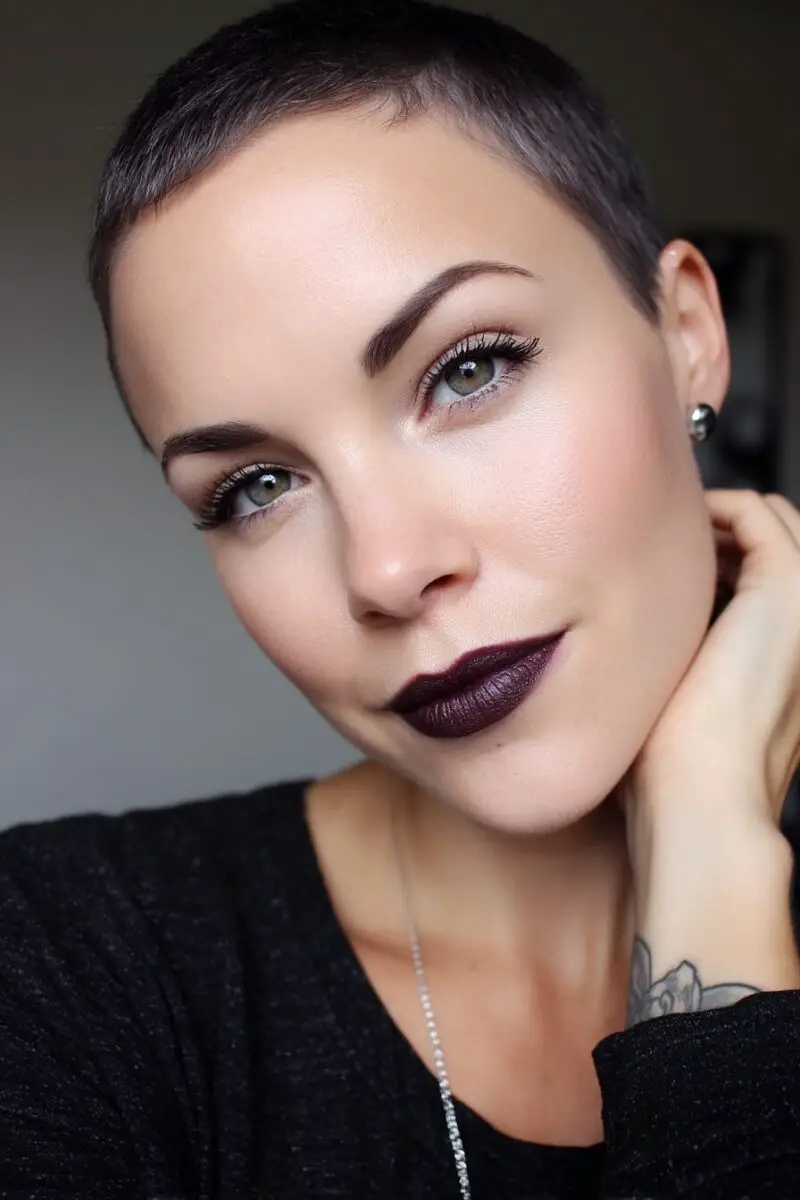

The ’90s vampy face rejected the dewy, highlighted skin that dominates today’s beauty trends, instead embracing a powder-matte finish that mimicked the porcelain perfection of Victorian dolls.
Achieving this look means starting with a foundation at least one shade lighter than your natural tone—the goal wasn’t a healthy glow but rather a slightly otherworldly pallor that suggested you avoided sunlight like a true creature of the night.
Revlon Colorstay was the holy grail foundation for many ’90s makeup enthusiasts, but modern equivalents like Fenty Beauty’s Pro Filt’r Soft Matte or L’Oreal Infallible 24Hr Fresh Wear deliver the same full-coverage matte effect with improved formulas.
After foundation, the quintessential ’90s technique involved generous application of translucent setting powder—not just to the T-zone but all over—creating that distinct flat, shine-free finish that defined the era.
Concealer was applied sparingly and only where absolutely necessary, as the vampy aesthetic embraced darkness under the eyes rather than fighting to brighten it away.
Blush was either completely absent or applied in cool, muted tones like mauve or cool taupe, placed higher on the cheekbones and blended back toward the hairline rather than on the apples of the cheeks.
The iconic ’90s vampy complexion deliberately avoided contouring as we know it today—instead, subtle shadow was created using ashy taupe powder placed slightly below the cheekbone to create a hollow, almost gaunt effect.
Highlighter was virtually non-existent in the traditional ’90s vampy look, though occasionally a touch of white matte powder might be applied to the highest points of cheekbones for a subtle dimensional effect.
For absolute authenticity, you’ll want to powder again after completing the rest of your makeup, ensuring not a hint of natural shine disrupts the flawlessly flat, matte canvas.
The modern twist on this look involves using setting sprays after powdering to remove the powdery texture while maintaining the matte finish—a technique that wasn’t available to your ’90s counterparts but preserves the spirit of the look.
Razor-Sharp Brow Arches: The Frame for Vampy Drama

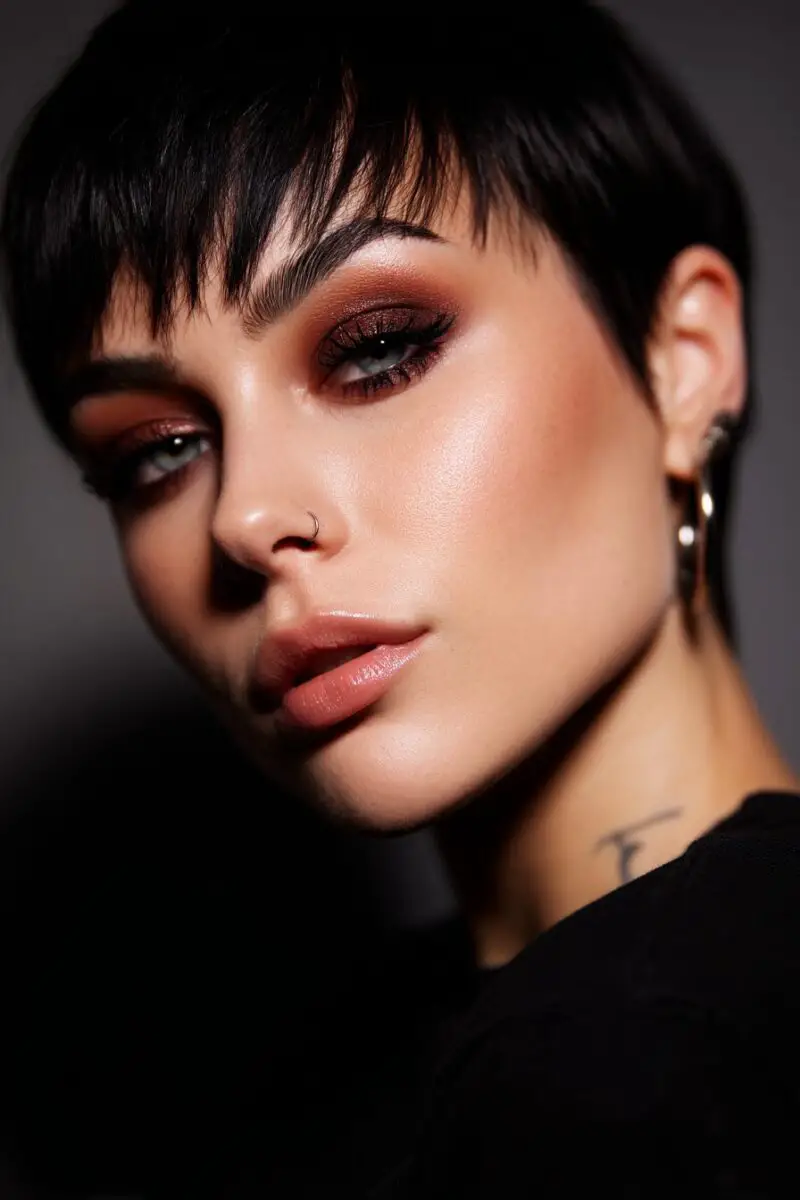
Long before the era of Instagram brows, ’90s vampy makeup featured thin, dramatically arched eyebrows that framed the face with an almost sinister expression of perpetual skepticism.
Unlike today’s full, bushy brows, the ’90s ideal showcased precisely tweezed arches that were often drawn on with dark pencil in a shape that extended beyond the natural brow line.
The technique involved tweezing brows into submission—removing hair from both above and below the natural arch to create a thin, defined line that sometimes measured only a few millimeters in width.
For authentic recreation, reach for eyebrow pencils in shades slightly darker than your natural color—deep brown, even for blondes, was the go-to choice that completed the vampy transformation.
The trademark ’90s brow shape featured a dramatic peak positioned approximately two-thirds of the way through the brow, creating an exaggerated arch that gave even the sweetest face a touch of villainous glamour.
Celebrity inspirations included Gwen Stefani, Drew Barrymore, and Angelina Jolie, all of whom embraced the pencil-thin, high-arched aesthetic that perfectly complemented their dark lip colors and pale complexions.
Unlike today’s gradient brows, ’90s arches maintained consistent color intensity from beginning to end, often applied with a heavy hand that left no question about whether the brows were enhanced.
The beginning of the brow typically started slightly further in from the natural starting point, creating a shorter, more geometric shape that opened up the eyes in a dramatically different way than today’s extended brows.
For absolute period accuracy, set your penciled brows with clear mascara rather than today’s brow gels—Maybelline Great Lash Clear was the unspoken standard for holding those perfect arches in place.
If you’ve already embraced modern full brows, try using concealer to cover the outer portions of your natural brow, then draw in the thinner ’90s shape—a temporary way to experience the dramatic difference this shape makes to your entire face.
Brown-Toned ’90s Contour: Subtle Hollow Cheeks

Before the Kardashian-inspired contour revolution, ’90s vampy makeup utilized subtle brown shadows to create mysteriously hollow cheekbones that captured the gaunt glamour of the grunge era.
Unlike today’s sharply defined contour, the ’90s version used matte taupe or cool brown eyeshadow—yes, eyeshadow—buffed softly beneath the cheekbones for a naturally shadowed appearance.
The placement was distinctly different too—higher under the cheekbone rather than in the hollow, and extended back toward the ear rather than down toward the mouth as modern techniques often suggest.
Products like MAC “Omega” eyeshadow or “Harmony” blush were staples in many makeup artists’ kits, providing the perfect ash-brown tone that mimicked natural shadow rather than creating obvious makeup lines.
Application involved long, soft brushes that distributed minimal product in gentle sweeping motions—the goal was the impression of shadow rather than the obvious stripe of contour that would become popular decades later.
The ’90s technique embraced subtlety in application but boldness in placement—sometimes extending the shadow upward toward the temples to create an almost supernatural hollowness to the entire cheek area.
For the most authentic recreation, use products with zero shimmer or glow—the ’90s vampy contour was resolutely matte, contributing to the overall flat, dimensionless quality that defined the era’s signature look.
The perfect ’90s vampy contour was often paired with no blush at all, allowing the brown shadow to serve as both contour and color, emphasizing bone structure while maintaining the pale, bloodless complexion so coveted during the decade.
Temperature was everything in selecting the right product—cool-toned browns that leaned gray rather than warm bronzers created that authentic “hollow” rather than “sun-kissed” appearance essential to vampy makeup.
To modernize this technique while maintaining its essence, try using cream contour products with cool undertones applied with a light hand, then set with translucent powder for that distinctly matte ’90s finish.
Under-Eye Smudged Liner: The Morning-After Magic
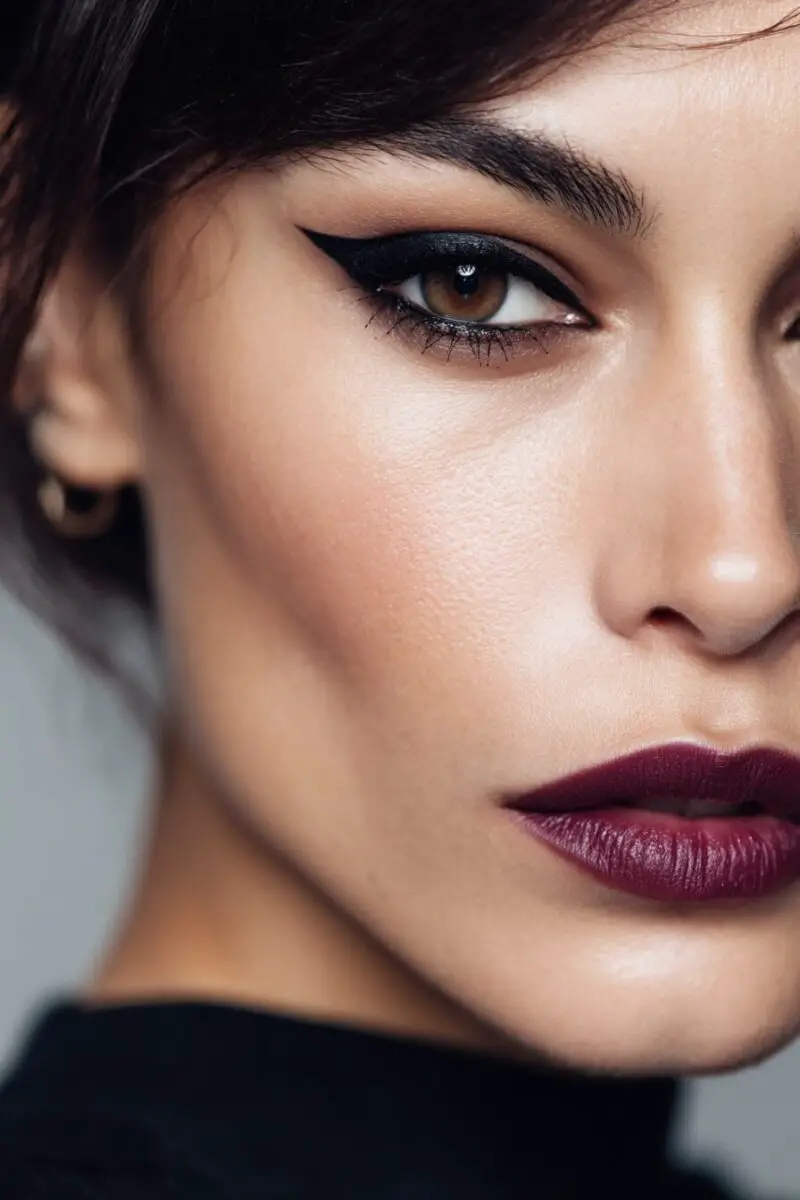
The intentionally imperfect under-eye liner defined ’90s vampy makeup, creating that coveted “been up all night doing something mysterious” look that perfectly captured the decade’s rebellion against polished perfection.
Unlike today’s precise waterline application, ’90s under-eye liner was deliberately applied below the lash line, then smudged downward with a finger or brush to create a shadowy, lived-in effect that suggested emotional depth rather than makeup skill.
Black was the dominant choice for creating maximum impact, but deep brown, plum, and even navy blue liners made appearances, especially when paired with corresponding shadow colors for a cohesive vampy statement.
The technique involved applying a soft pencil liner—never liquid—directly beneath the lower lashes, then using a small smudge brush or pinky finger to drag the color downward, creating a soft gradient rather than a sharp line.
Urban Decay’s “Zero” and MAC’s “Smolder” were the reigning champions of ’90s under-eye liner, offering the perfect balance of intense pigment and smudgeable texture that stayed put after the initial blending.
The placement extended all the way to the inner corner—a technique modern makeup often avoids—creating a fully enclosed eye that enhanced the mysterious, slightly dangerous aura of the vampy aesthetic.
For maximum ’90s authenticity, pair your smudged under-eye liner with mascara on both upper and lower lashes, focusing on the roots of lower lashes to intensify the shadowy effect without creating spider-like extensions.
The beauty of this technique lies in its democracy—it actually works better on tired eyes with natural shadows, embracing and enhancing the darkness rather than fighting to conceal it with brightening products.
To keep this look feeling intentional rather than messy, maintain relative precision on the upper lid—the contrast between sharp upper liner and smudged lower liner creates the perfect balance of control and chaos.
Skinny Two-Toned Lips: The Vampy Liner Technique
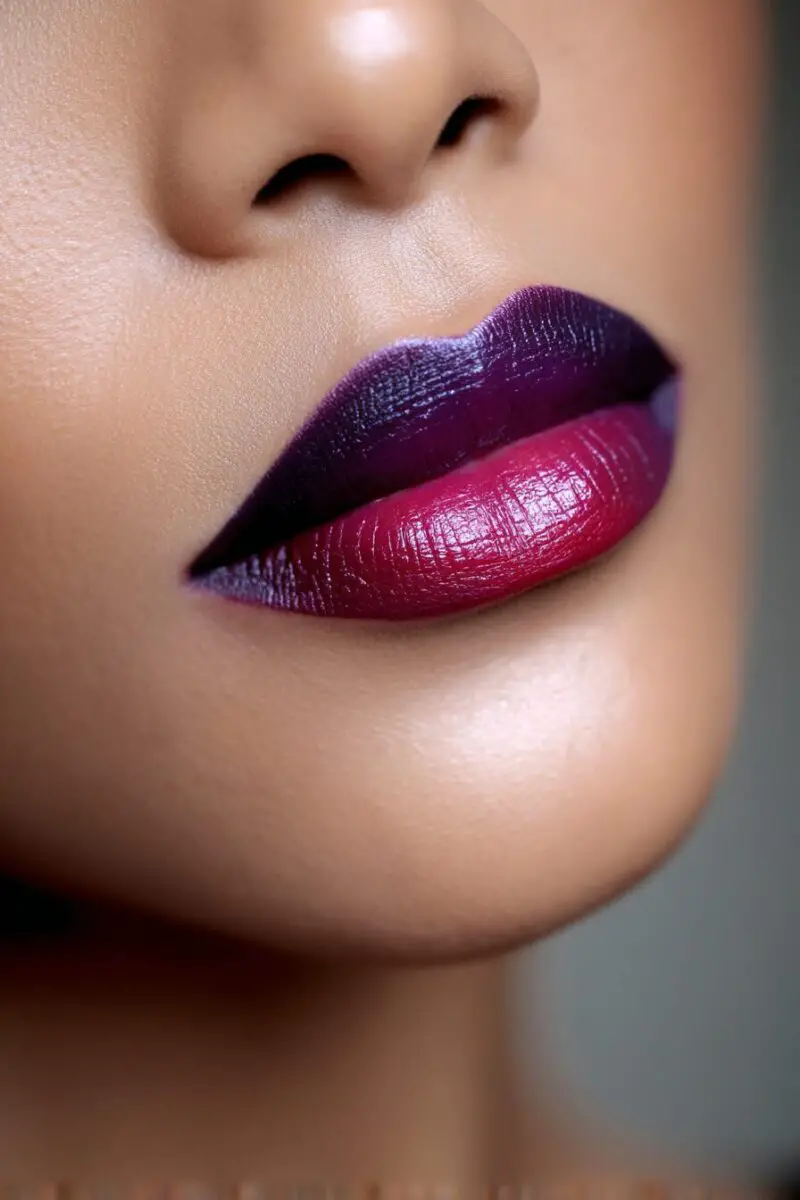

Long before the over-lined lips of today’s beauty influencers, ’90s vampy makeup pioneered a distinctly different lip technique—the dramatically visible lip liner paired with slightly lighter lipstick that created dimension through contrast rather than volume.
For a modern adaptation that maintains the spirit of ’90s vampy under-eye liner while feeling current, try using a dark eyeshadow applied with a small angled brush instead of a pencil, creating a softer effect that’s less likely to migrate throughout the day.
Unlike today’s seamlessly blended lip looks, the ’90s deliberately showcased the dark liner, creating a visible outline around the entire lip that remained distinctly darker than the lipstick inside it.
The color combinations weren’t subtle—think blackberry liner with mauve lipstick, deep chocolate liner with coffee-toned lipstick, or even black liner with deep burgundy, creating a gradient effect that added mysterious depth to the pout.
Iconic brands like Revlon and MAC dominated this trend, with MAC’s “Spice” and “Nightmoth” liners achieving legendary status when paired with lipsticks like “Twig” or “Verve” for the perfect two-toned vampy lip.
The application technique was specific—liner applied precisely along the natural lip line (never overdrawn at the corners, though sometimes slightly extended at the cupid’s bow), followed by lipstick applied only to the center, with minimal blending between the two.
This technique embraced the visible line rather than trying to disguise it, creating a makeup look that was obviously “done” rather than attempting to mimic natural lip coloration—a distinctly ’90s approach to beauty that celebrated artifice.
The skinny two-toned lip became especially popular among R&B and hip-hop artists, with performers like Aaliyah, TLC’s T-Boz, and Mary J.
Blige showcasing various iterations of this look throughout the decade.
Metallic Brown Eyeshadow: The Forgotten ’90s Essential
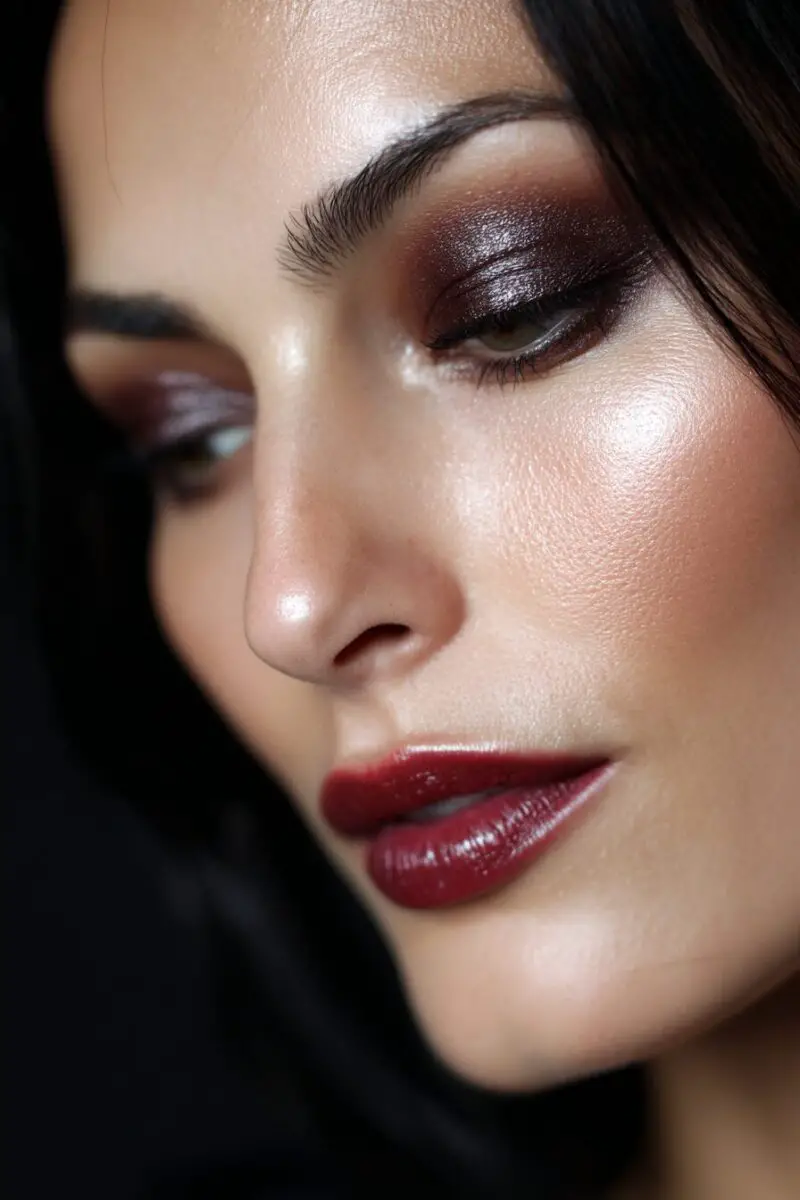
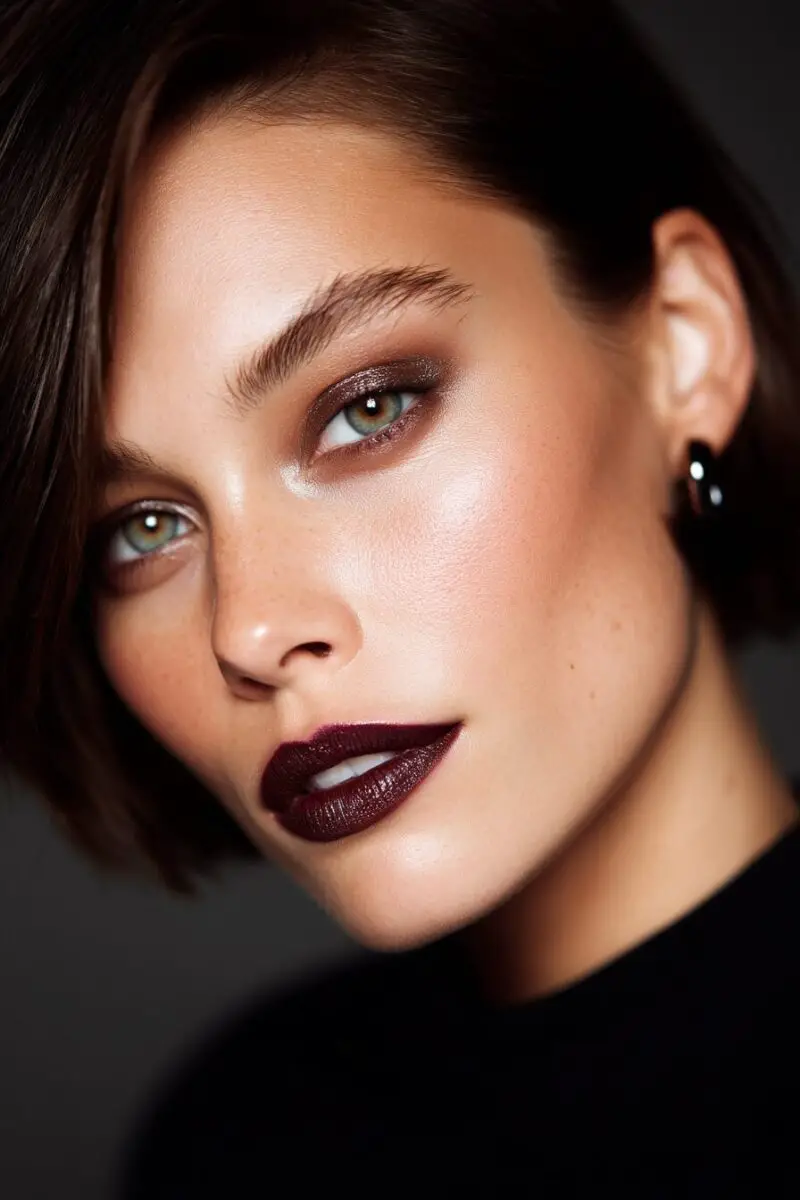
While black and gray shadows might seem like the obvious choice for vampy looks, the ’90s actually embraced rich metallic brown eyeshadows that created mysterious depth without the harshness of darker shades.
These weren’t the warm, coppery browns popular today, but rather cool-toned metallic taupe-browns with subtle shimmer—think the color of dark chocolate with a hint of bronze rather than today’s orange-leaning warm tones.
Products like Urban Decay’s “Smog,” MAC’s “Bronze,” and Revlon’s “Copper Penny” dominated ’90s makeup bags, offering the perfect balance of wearable brown with enough metallic dimension to catch club lighting.
Application was less precise than today’s techniques—often applied with fingers rather than brushes, concentrated on the mobile lid and smudged upward toward the crease without distinct transition shades or cut creases.
The ’90s approach embraced a single-shadow look rather than today’s complex multi-shadow techniques, allowing the dimensional quality of the metallic finish to create natural highlights and shadows as the light hit different angles.
Pairing was essential—these metallic browns were typically combined with black or brown liner smudged into the lash line, creating a cohesive gradient from metallic lid to intense lash definition.
For darker skin tones, the ’90s vampy brown shadows created a subtle smoky effect that enhanced natural eye color without overwhelming the face, while on lighter skin tones these shadows created dramatic contrast.
The finish was key to authenticity—not the ultra-sparkly metallics of later decades, but rather a subtle shimmer that created dimension without obvious glitter, maintaining the sophisticated edge of true vampy makeup.
Unlike today’s precise application methods, the ’90s technique allowed for these metallic browns to fade and crease throughout the night, actually improving the lived-in, vampy quality as the evening progressed.
To modernize this look while maintaining its essence, try using contemporary metallic brown shadows like Natasha Denona’s “Bronze,” Charlotte Tilbury’s “The Dolce Vita,” or ColourPop’s “On the Rocks”—applied with fingers for authentic texture but with a modern primer underneath for improved longevity.
Glossy Lids: The Unexpected ’90s Vampy Trend
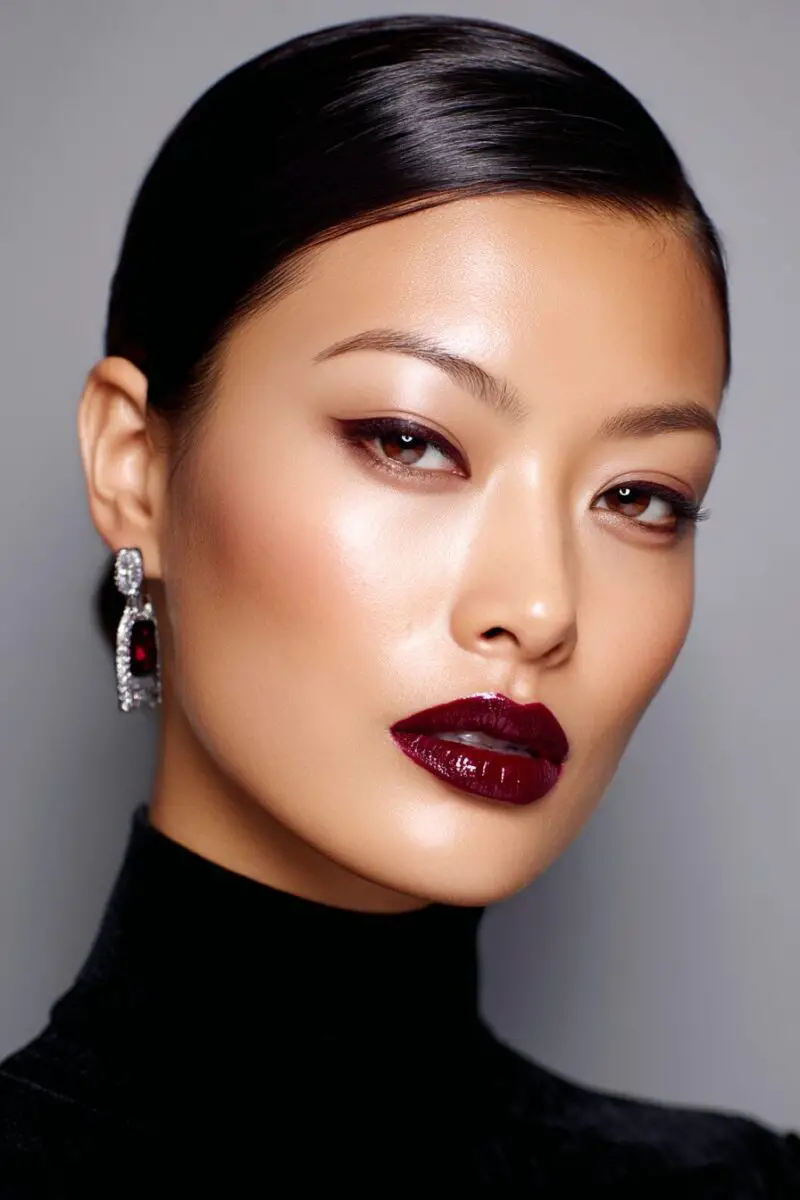
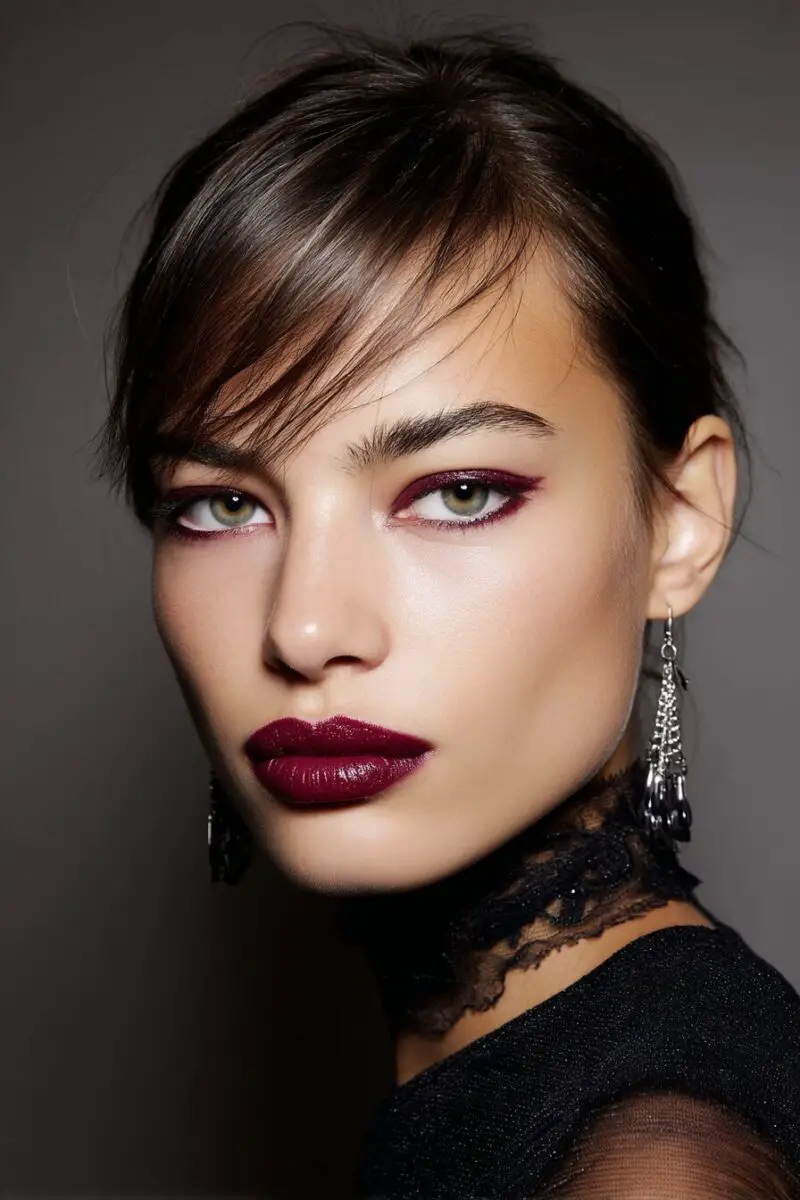
Before the recent revival of glossy lids, the ’90s vampy scene pioneered this editorial-inspired technique, using clear lip gloss or petroleum jelly over dark shadows to create a wet, slightly undone eye look that screamed high-fashion grunge.
Unlike today’s specialized eye glosses with staying power, the original ’90s technique embraced the inevitable creasing and movement, considering it part of the lived-in, slightly messy aesthetic that defined the era’s rebellion against perfection.
The technique involved applying a dark powder shadow—often black, deep brown, or plum—to the lid, then tapping a small amount of clear gloss over top, creating instant dimension that photographer Steven Meisel captured in countless ’90s fashion editorials.
This look gained mainstream popularity when brands like Hard Candy released their eye gloss products, though most makeup enthusiasts simply repurposed their Lip Smackers or Vaseline to achieve the same effect.
The appeal of glossy lids in vampy makeup lies in their ability to create instant intensity—the reflective quality of the gloss makes even sheer dark shadow appear more pigmented and dramatic without additional product.
For authenticity, pair glossy lids with completely matte skin elsewhere—the stark contrast between intentionally shiny eyes and powder-matte complexion created that distinctive editorial quality that separated fashionable vampy looks from everyday makeup.
The placement was typically concentrated on the mobile lid only, keeping the crease matte to prevent uncomfortable stickiness when blinking, though more daring ’90s makeup artists occasionally glazed the entire eye area for maximum impact.
This technique worked particularly well with flash photography, capturing light in a way that made eyes appear larger and more dramatic—a favorite trick of ’90s music video directors filming bands like Garbage, Nine Inch Nails, and The Smashing Pumpkins.
The modern adaptation involves using specialized eye glosses with improved formulations, like Danessa Myricks Colorfix Glaze or NYX Lid Lacquer, which offer better wear time while maintaining that authentic wet-look finish.
For a subtle nod to this ’90s trend, try applying gloss only to the center of the lid over dark shadow—creating dimension without the full commitment to the inevitable messiness that made this look simultaneously challenging and cool.
Monochromatic Burgundy: The Ultimate Vampy Coordination
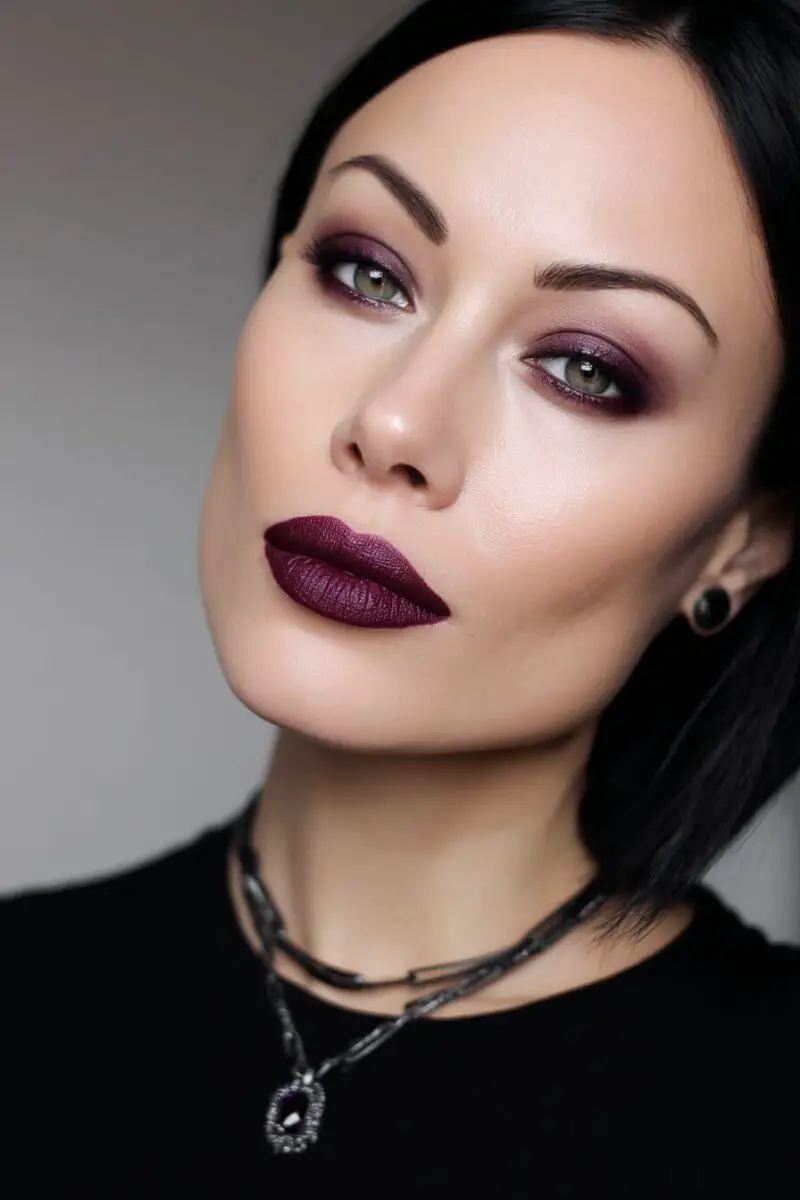
The pinnacle of ’90s vampy makeup artistry involved coordinating the same deep burgundy shade across eyes, lips, and cheeks—a monochromatic approach that created sophisticated cohesion before “matching your makeup” became a documented trend.
Unlike today’s monochromatic looks that often feature brightening techniques, the ’90s version embraced the darkening effect of all-over burgundy tones, creating a deliberately dramatic and slightly sinister appearance.
The technique involved using lip products on cheeks and even eyes—MAC’s “Diva” lipstick wasn’t just for lips but doubled as cream blush and eye color for makeup artists seeking perfect color matching before multi-use products became mainstream.
For eyes, burgundy shadow was applied as a wash all over the lid and beneath the lower lash line, often with black liner at the roots of lashes to maintain definition without breaking the color story.
Cheeks featured the same burgundy tone applied higher on the cheekbones rather than on the apples, creating sculptural definition through color placement rather than traditional contour techniques.
Lips completed the look with the same burgundy shade in a matte or satin finish, slightly overlined at the cupid’s bow but never extended beyond the natural lip line at the corners—a subtle shaping technique that defined the era.
The beauty of this monochromatic approach lies in its simplicity—one perfect burgundy product could theoretically create an entire face of makeup, making it both editorially striking and practically efficient.
For modern recreation, products like Rituel de Fille’s Inner Glow Pigment in “Desire” or Makeup by Mario’s Master Mattes in “Burgundy” offer multi-use formulations specifically designed for this type of coordinated application.
The key to preventing this look from appearing flat or one-dimensional lies in varying the intensity across the face—sheer application on cheeks, medium intensity on eyes, and full opacity on lips creates natural hierarchy.
To make this distinctly ’90s technique work for contemporary beauty standards, try adding a touch of clear balm to the high points of cheekbones after applying your burgundy shade—maintaining the monochromatic color story while adding subtle dimension.
The beauty of ’90s vampy makeup lies not just in its aesthetic appeal but in its attitude—a dark glamour that rejected conventional prettiness in favor of something more interesting, more dangerous, and ultimately more powerful.
The cyclical nature of beauty trends means these vampy techniques aren’t just nostalgic throwbacks but relevant inspirations for contemporary makeup, ready to be rediscovered by a new generation seeking alternatives to glowing, filtered perfection.
After all, embracing your dark side never really goes out of style.

